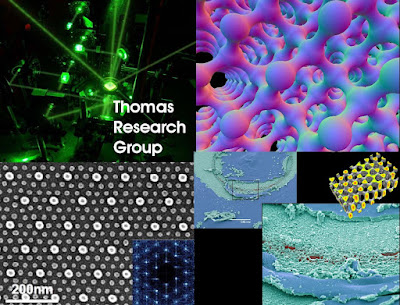Clipped from: Self-assembling computer chips
Self-assembling computer chips
Molecules that arrange themselves into predictable patterns on silicon chips could lead to microprocessors with much smaller circuit elements.
The features on computer chips are getting so small that soon the process used to make them, which has hardly changed in the last 50 years, won’t work anymore. One of the alternatives that academic researchers have been exploring is to create tiny circuits using molecules that automatically arrange themselves into useful patterns. In a paper that appeared Monday in Nature Nanotechnology, MIT researchers have taken an important step toward making that approach practical.
MIT researchers coaxed tiny, chainlike molecules to arrange themselves into complex patterns, like this one, on a silicon chip. Previously, self-assembling molecules have required some kind of template on the chip surface — either a trench etched into the chip, or a pattern created through chemical modification. But the MIT technique instead uses sparse silicon “hitching posts.” The molecules attach themselves to the posts and spontaneously assume the desired patterns.
Image: Yeon Sik Jung and Joel Yang
Image: Yeon Sik Jung and Joel Yang
Clipped from: Magnetic Materials and Devices Group - MIT
Research Areas:
Prof. Ross’s group research is directed towards the following areas:- Fabrication of magnetic films, multilayers and small magnetic structures, with applications in magnetic logic, magnetic random access memory, hard disks, and bit-patterned media
- Magnetooptical oxides including perovskites and other oxides for use in integrated optical components such as magnetooptical isolators
- Self-assembly of block copolymers, with particular application to nanolithography, and in other self-assembling systems such as dewetting of thin metal films and porous alumina formation.
Clipped from: Thomas Research Group
MISSION
Our research is focused on the development of novel polymers and polymer-based composite materials with unusual optical, mechanical, and electronic properties. The research is very interdisciplinary with members having backgrounds in materials science, chemistry, physics and mechanical engineering. The main areas of current interest include photonics, phononics, mechanical properties of complex materials, and polymer structure and morphology.
Clipped from: Molecules could create tiny circuits on computer chips
Molecules could create tiny circuits on computer chips
With its minor reliance on electron-beam lithography, the new method could offer cost-effective fabrication in areas besides computer chips. For example, the technique could be used to produce stamps for creating magnetic patterns on hard disks, which are currently produced with electron-beam lithography. However, more research is required before manufacturing individual computer chips with self-assembling molecules, such as getting the molecules to form the exact patterns needed to produce functioning circuits.
More information: Joel K. W. Yang, Yeon Sik Jung, Jae-Byum Chang, R. A. Mickiewicz, A. Alexander-Katz, C. A. Ross & Karl K. Berggren. “Complex self-assembled patterns using sparse commensurate templates with locally varying motifs.” Nature Nanotechnology. Doi:10.1038/nnano.2010.30.
via: MIT News
Sources:
- Self-assembling computer chips
- Magnetic Materials and Devices Group - MIT
- Thomas Research Group
- Thomas Group Research
- Molecules could create tiny circuits on computer chips
- Building microchips from the bottom up (8/16/2008)
- MIT building self-assembling computer chips | Crave - CNET
- Microsoft Word - chuang_tsa.doc - Powered by Google Docs
- Molecules arrange themselves into predictable patterns
- Building microchips from the bottom up
- DMSE - Faculty - Caroline A. Ross
- Complex self-assembled patterns using sparse commensurate templates with locally varying motifs : Abstract : Nature Nanotechnology

